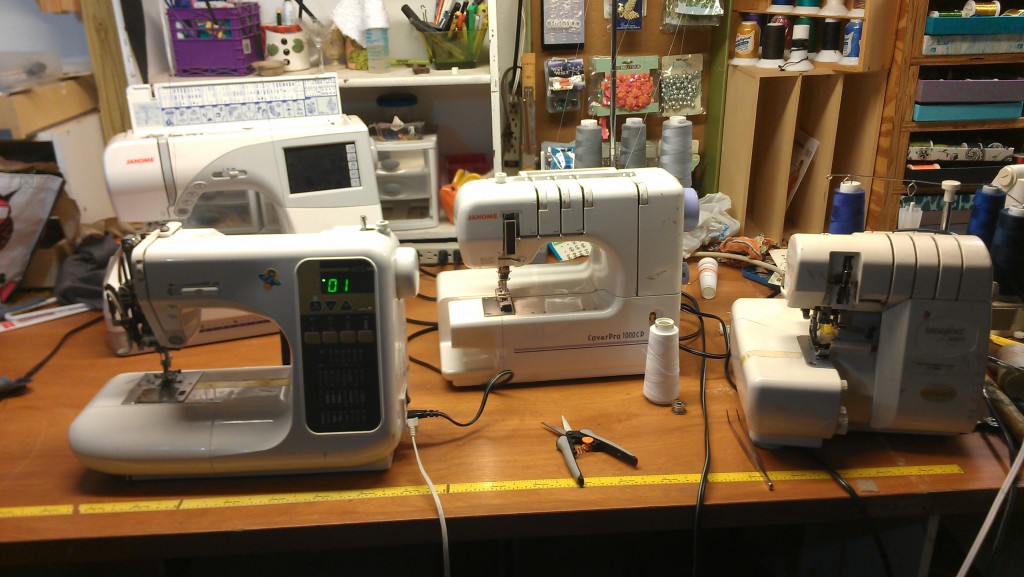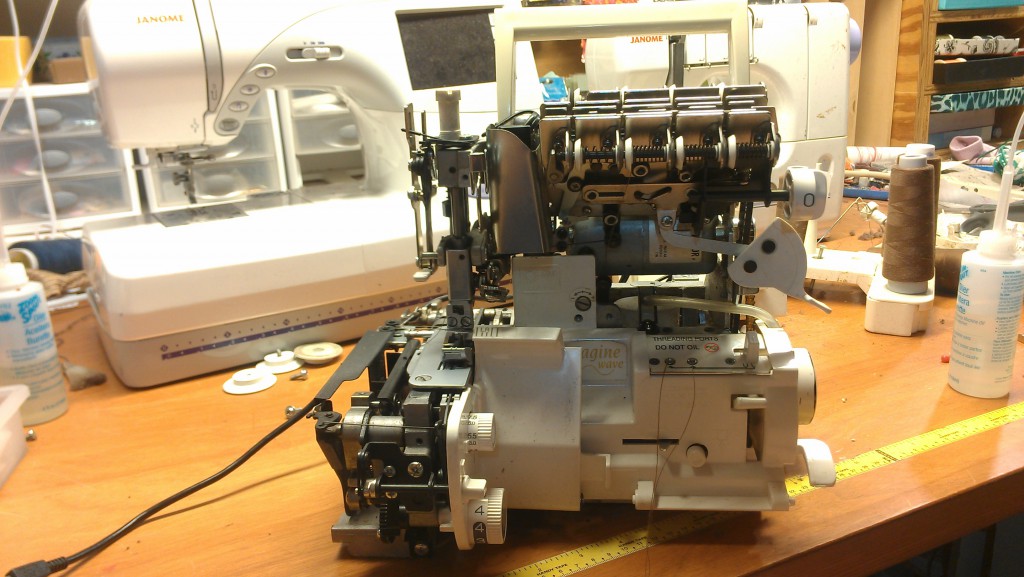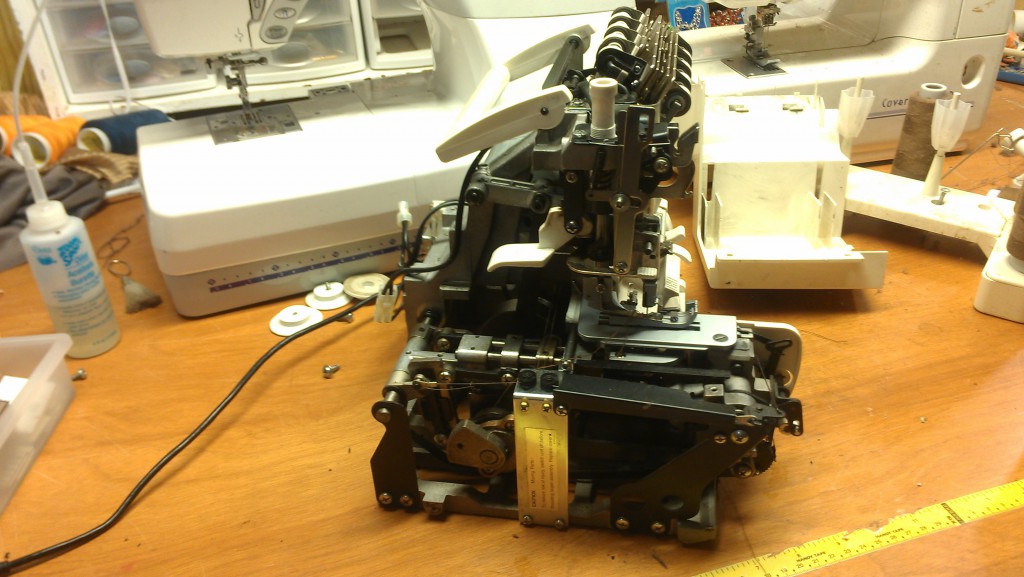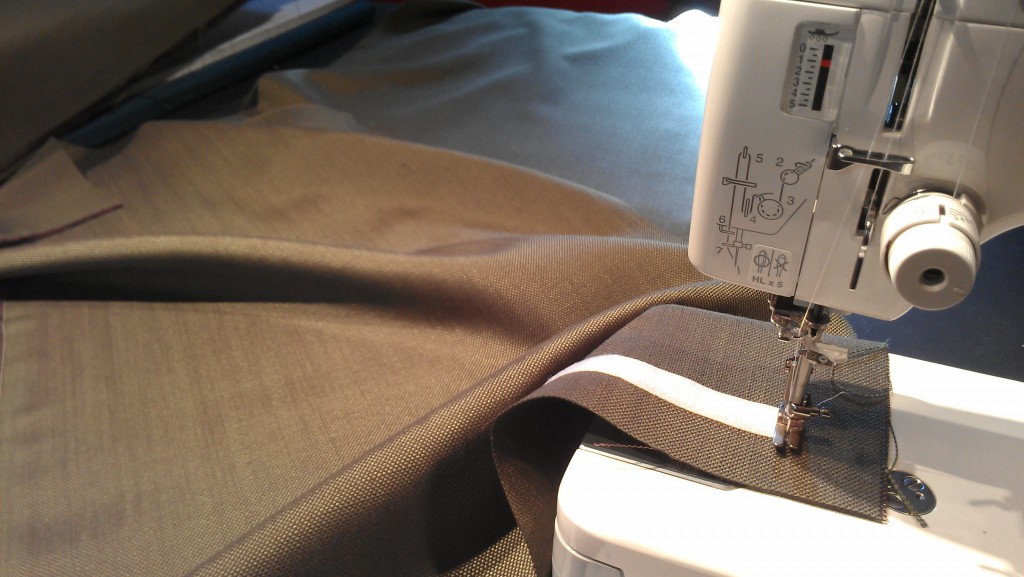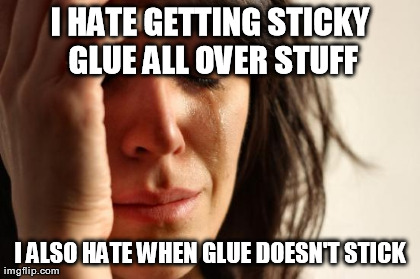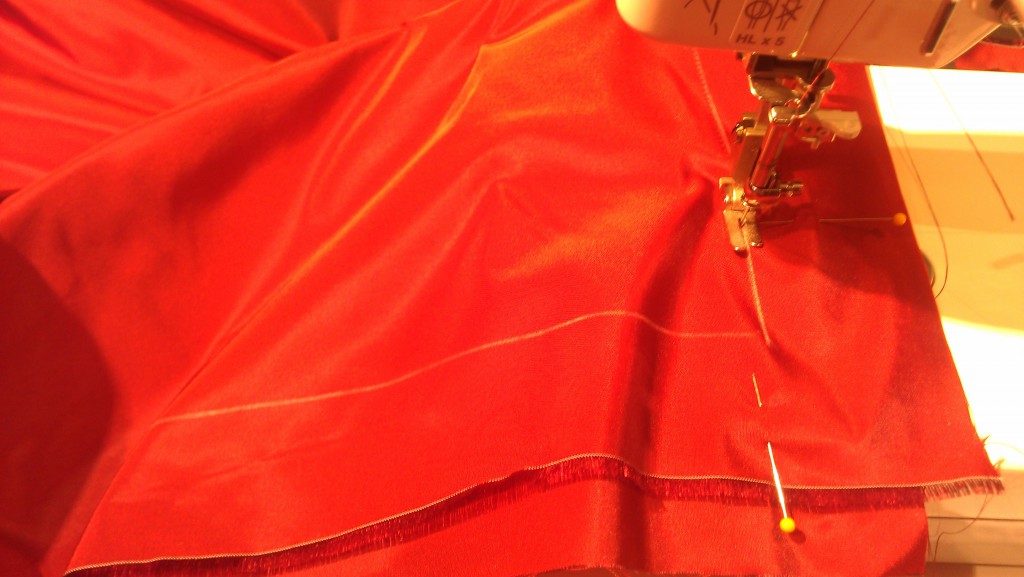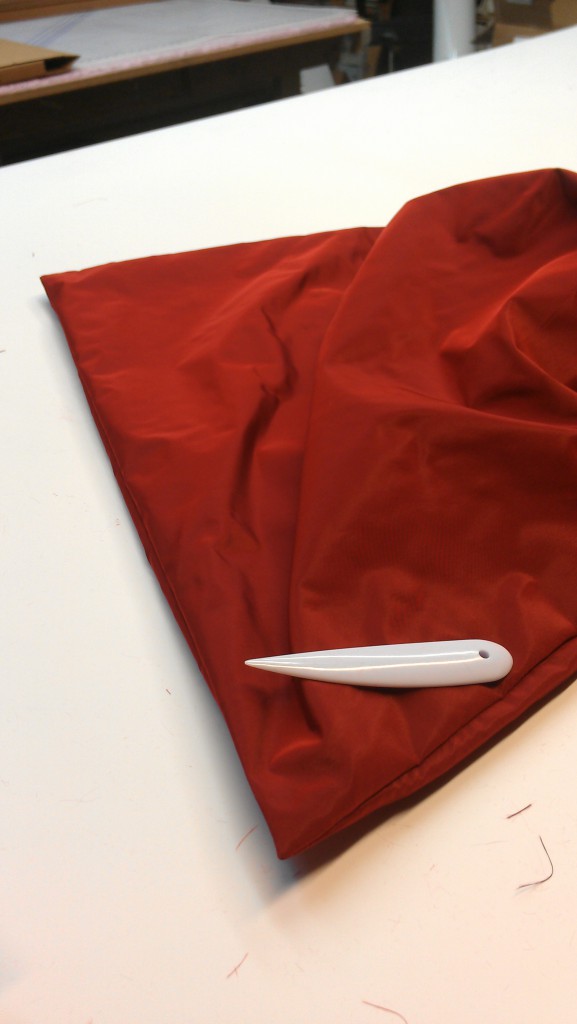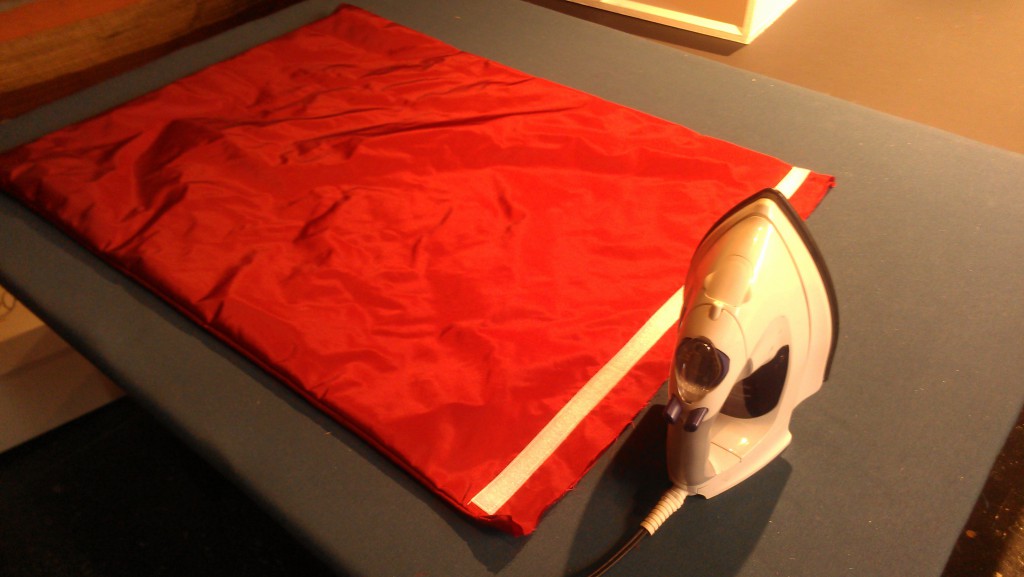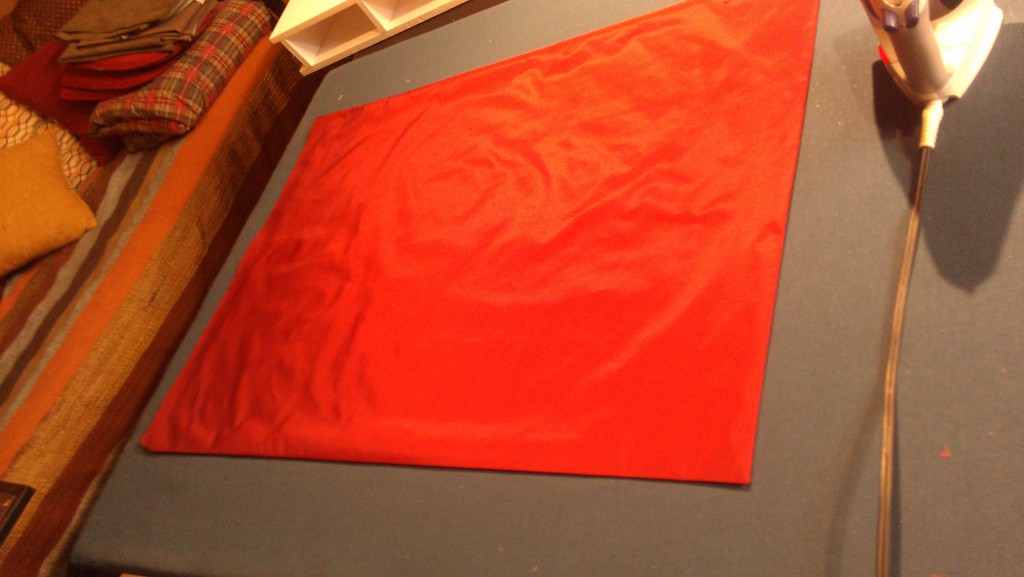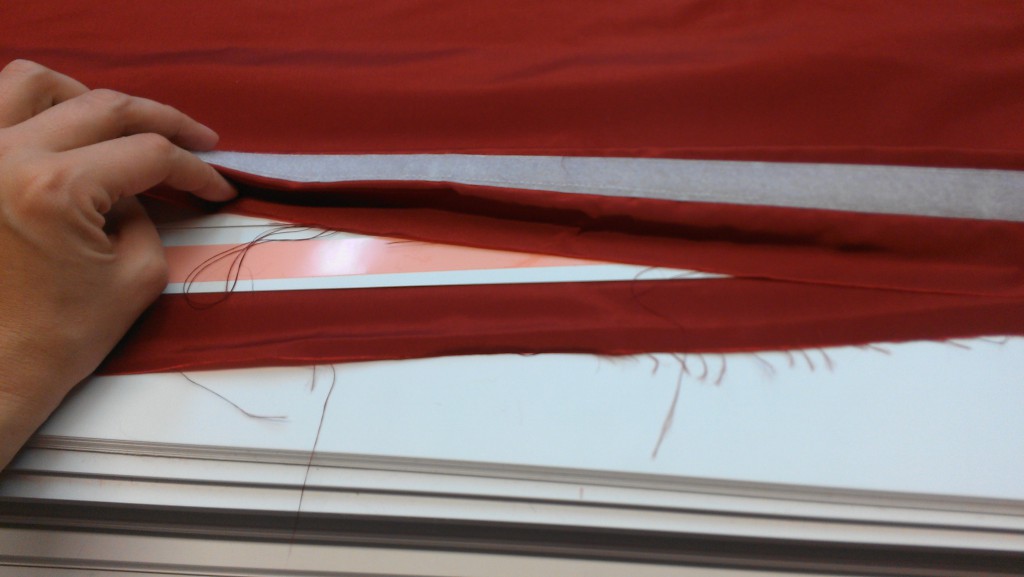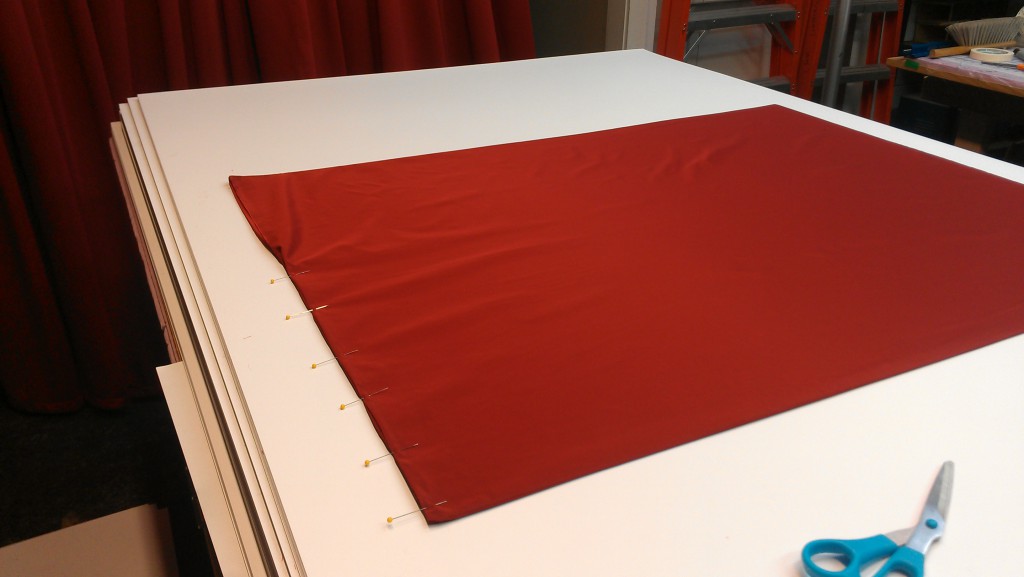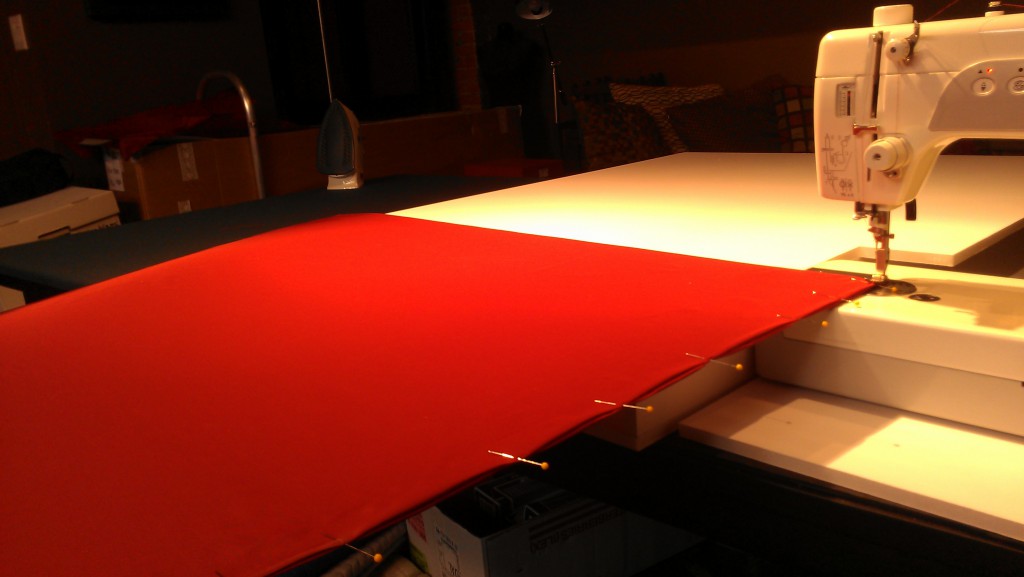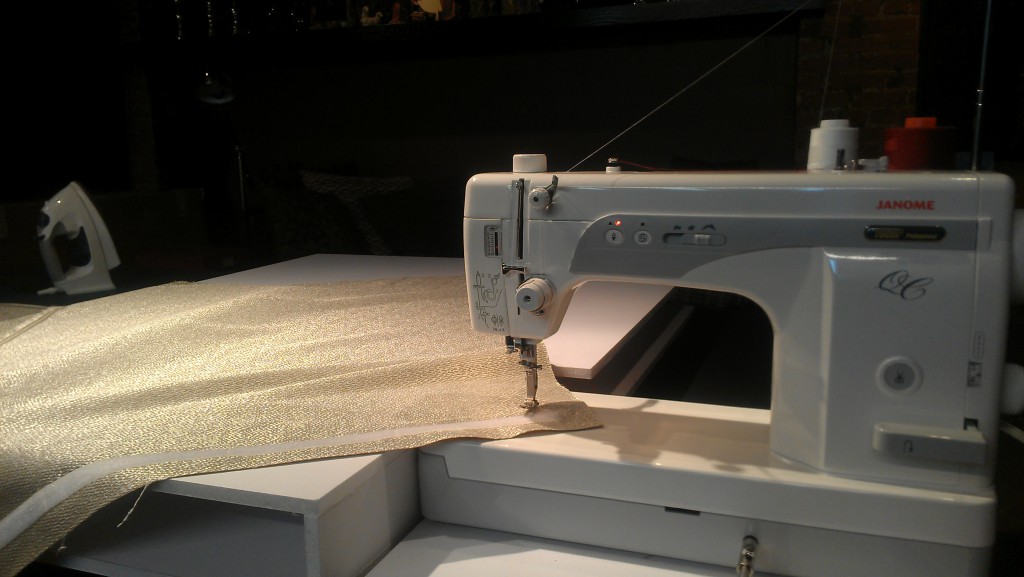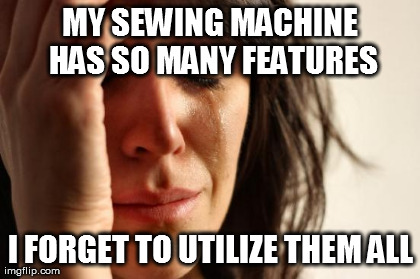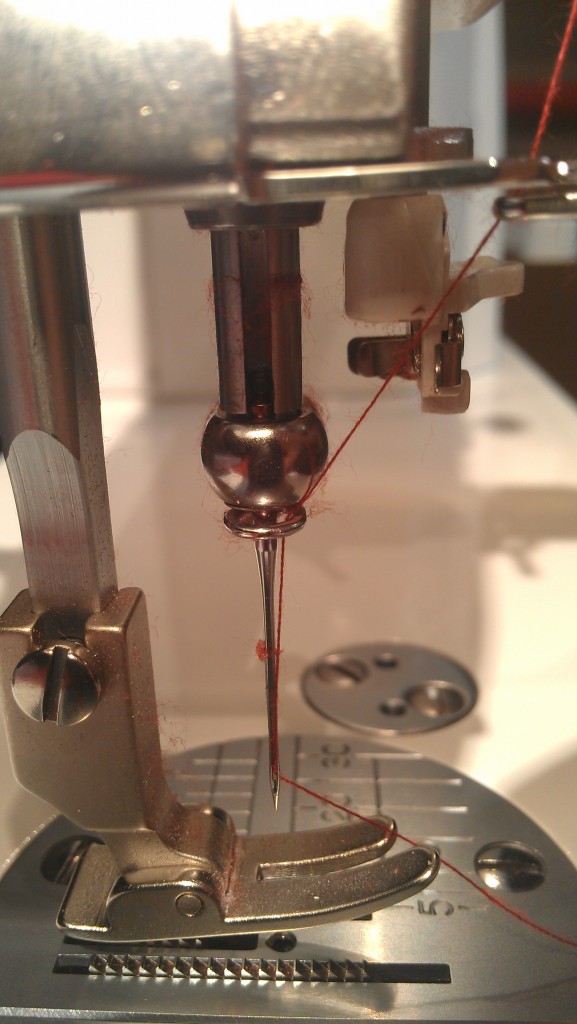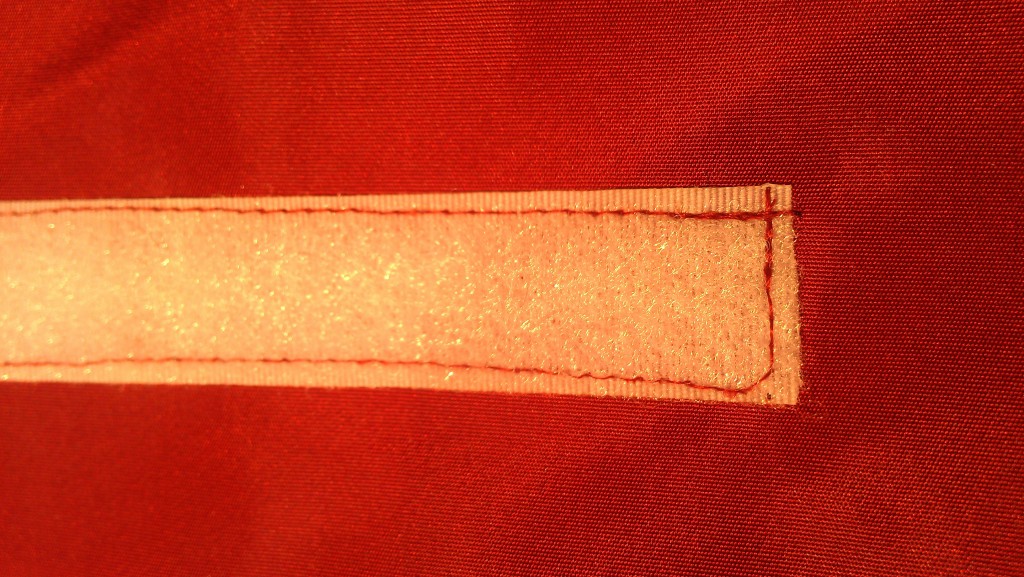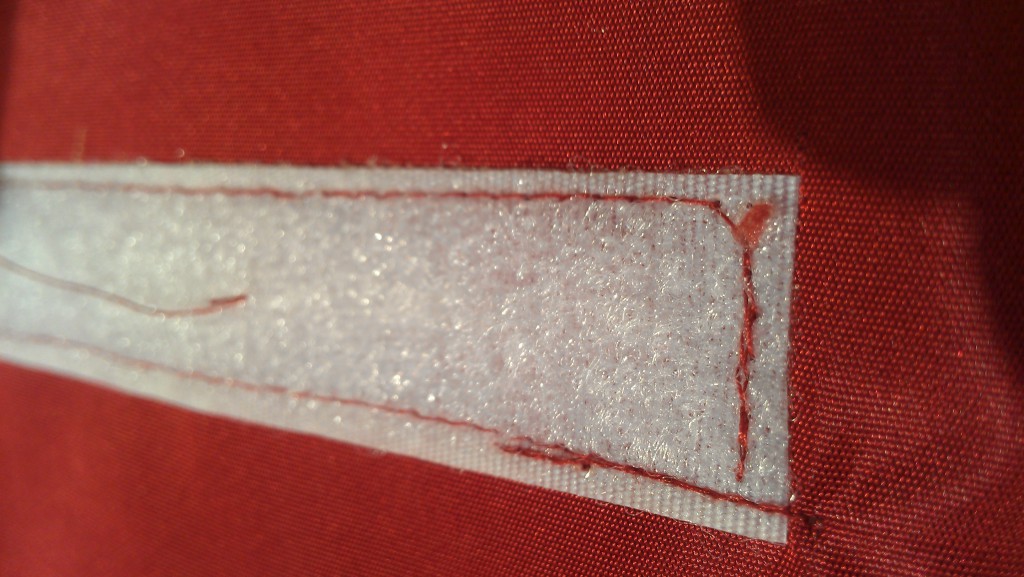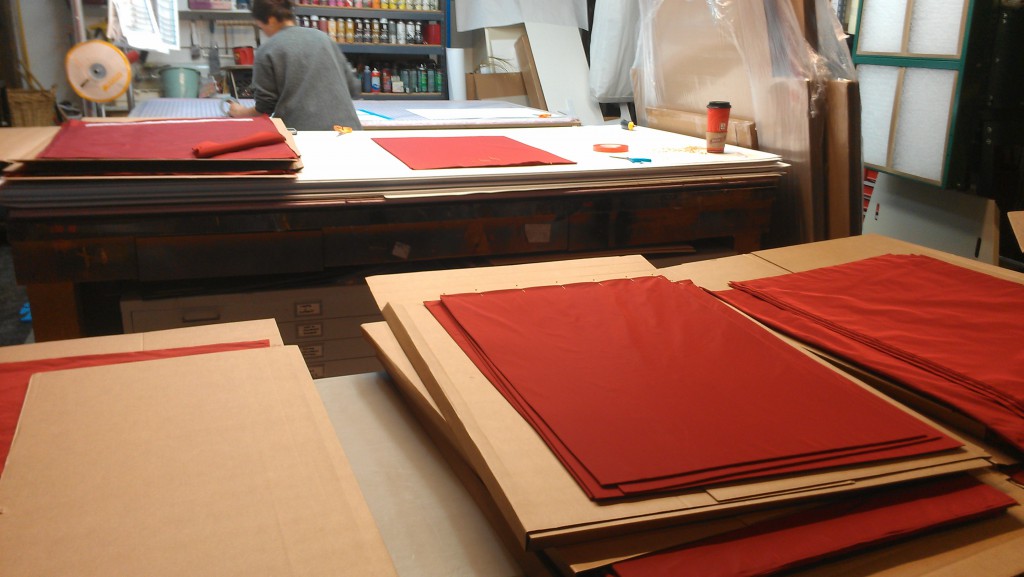In case the last picture in my previous post looked almost like an ad for the sewing machine in the background, it is not. In fact, the only reason I am using that machine is because the one I call Jurgis was knocked out of alignment after a fall of about a foot and a half and I haven’t gotten around to taking him to the doctor. The machine I call The Princess needs a new light bulb, and, in keeping with her name, she requires a certain kind of light bulb not to be found ANYWHERE. Plus, she’s been used to sew over a thousand strips of sticky-back velcro and while I cleaned the glue residue out well enough to keep her going through the marathon, I haven’t yet gone back and done a thorough job of it. Which is probably the reason she’s periodically snapping thread.
(Warning, this entry is long and rambling. I have added pictures of my cat to keep the visual-oriented readers going.)
So in the meantime, I’m using the Janome convertible embroidery machine. I used to work for a Janome/ BabyLock dealer, and I used to work at Hancock Fabrics, which sells Janomes and at least once a year, has Janome staff come and demonstrate their machines, including the embroidery machines. That’s why I know what I’m talking about when I say do not buy a Janome embroidery machine.
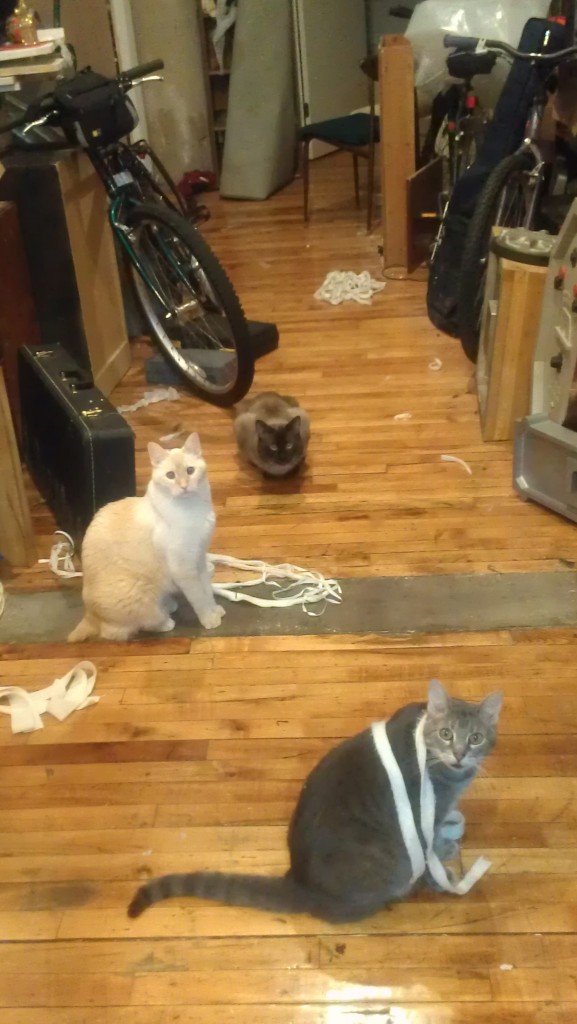
The main problem is that, while Janome was the first to bring embroidery into homes, it seems to be riding on that, rather than keeping up with the market. They are one of the hardest to line up if you have to move the fabric in the hoop to have more than one embroidery on one piece of fabric. Even the demonstrator only showed us how to do that using a random-patterned, overlapping, repeating-rose fabric where the exact placement of the next rose wasn’t important.
They also have relatively small hoops–BabyLock’s were the biggest the last time I checked in.
As far as sewing machines go, Janome is fabulous. Usually. First a rant before I extoll the virtues of nearly every other Janome but this individual.

Most of its problems probably have to do with a flaw or damage in the computer. It randomly gets stuck on reverse. There is no way to tell in advance whether it is going to start sewing backward or forward when I push the pedal. This is potentially serious in fabrics that don’t heal well from needle punches or in places where it is hard to rip out stitches. It’s also time-consuming and frustrating. It’s like not knowing when you start your car whether it’s going to randomly reverse or go forward. There is no reason for any machine to do this. Pleeease tell me this is a computer error and not a design element.
When the bobbin gets down to about a two-thirds empty, it starts warning me that I need to change it. This means that when I push the pedal, the machine will, instead of sewing, beep several times and cover the screen with a warning sign. While this makes sense if I am starting a large piece of embroidery that will be ruined if it runs out of bobbin thread in the middle, it makes no sense when I’m sewing. Perhaps a different setting for sewing vs. embroidering? I can nearly sew a whole garment with the thread left on the “empty” bobbin it keeps warning me to remove.
Not only do I have to then push the okay button and wait a few seconds for it to contemplate my disagreeableness, but when it’s feeling really concerned about leaving me to my own ruinous devices, it will only sew about 6 or 7 stitches very slowly then stop, at which point I have to pump the foot pedal to get it going again. While it is in this mood, I usually can’t push reverse in mid-stitch, as it will just keep sewing forward; I have to come to a complete stop to reverse, stop, then sew forward. Sometimes it’s reluctant to even do that, and will attempt to completely ignore the reverse button.
Periodically the touchscreen will stop identifying touch, and I have to power off the machine in order to change stitches.
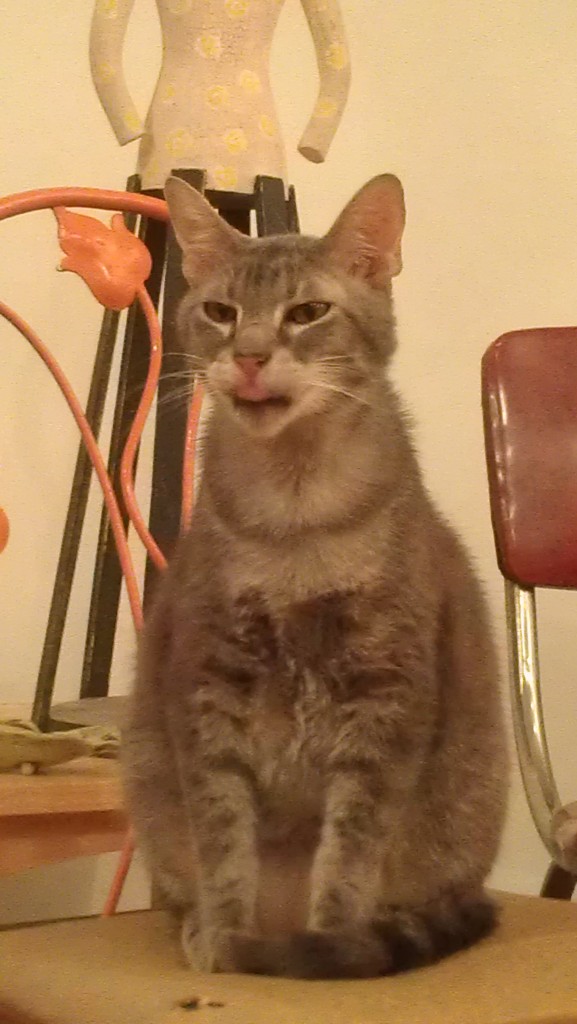
A lot of electronic machines have this annoying thing they do where when you take your foot off the pedal in the universal gesture for “stop,” they keep going 1 or 1.5 stitches. This is annoying. However, this machine keeps going 2-3 stitches. There is no such thing as precision sewing with this machine, and there is a lot of stitch-ripping.
I hate this individual machine almost enough to throw it out the window. I am going to assume all this stuff is a defect rather than any of it at all being a design flaw. So, as a machine in general, having a Janome embroidery machine as a sewing machine is approximately as nice as having any embroidery machine as a sewing machine. There are a huge assortment of built-in stitches that look like embroidery but are done while it is in sewing mode, including one font of writing.
In comparison to BabyLock, however, these features are really puny. The size of BabyLock embroidery sewing stitches is impressive; they also have three fonts you can sew with.
The Janome and BabyLock dealer I used to work for liked being able to sell the lower-end Janomes so we could have a broader client base than the expensive BabyLocks would allow, but didn’t want to have to be dishonest enough to push the embroidery machines. When Janome said we had to sell their machines at every price point, we stopped carrying them. That’s right, a dealer refused to sell them because he didn’t want to be responsible for that. The one embroidery Janome we sold was to someone who came in already convinced that that’s what she wanted.
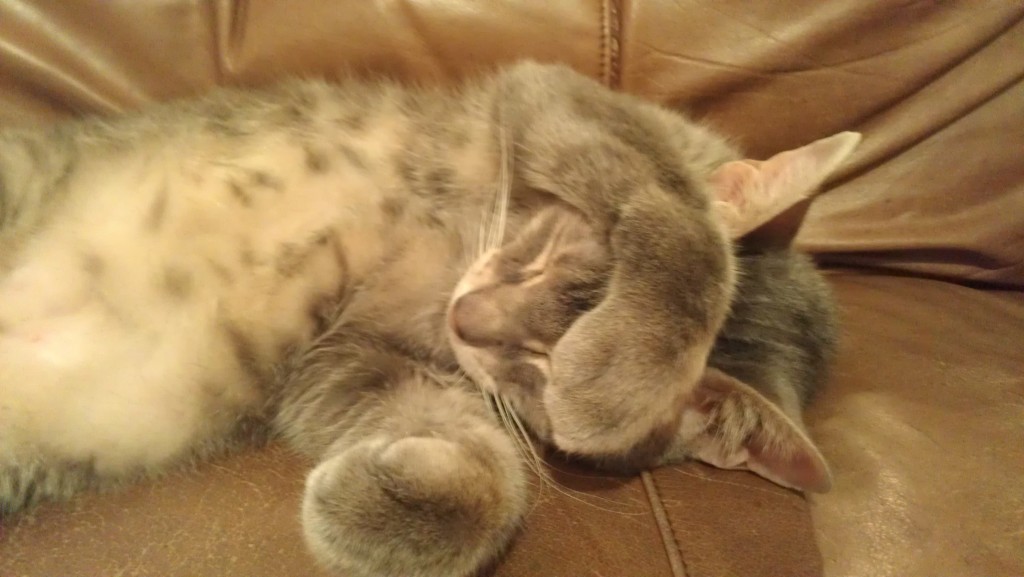
On the other hand, as machines, they are fabulous. It is the same company as New Home and Kenmore, so if you see any of those names, there’s no difference besides branding. Every machine I use besides my BabyLock serger is marked with one of those three names. They are high-quality machines that are usually found at very reasonable prices. They often go on sale, and signing up for fliers at your local chain fabric store that carries them can help keep them within almost any budget.
One thing for a buyer to look for is a 4-step vs. a 1-step buttonhole. New sewers, as well as experienced sewers who assume that this is such old and obvious technology that it ought to come standard, should verify the buttonhole feature when buying. The lowest-end machines will generally have a 4-step. This stinks. I have seen a difference of $60 and up between machines that have only this difference. This stinks, too.
Most people will use a buttonhole at some point. I say that it is definitely worth it. However, in a tight budget, you might assess your planned garments and determine how often one would be needed. Some people love snaps. Then there’s always velcro. And zippers.

Not counting those horrible, horrible little toy sewing machines, which get as low as $20ish to $50, and are good for nothing but shot put, Janome is great at any price point. The sewing class held at Hancock Fabrics daily during the summer, and several times a week during the school year got heavy use from several children, and the class machine was the lowest end Janome (it sold for around $70 at that time; I don’t think it gets that low even on sale anymore, though). They held up well enough to seem nearly new over a year later.
There is a difference between buying a machine in a fabric store or from a dealer–they are much higher quality and have stronger engines when purchased from a dealer. They also tend to have better warranties, and better educated salespeople who can help you determine what features you need and who can show you how to use it. Getting quality sewing machine help at a fabric store is a lottery, and the odds are getting worse all the time. At one point, I went into Joann’s to buy a snack while I was waiting around at the laundromat in the same shopping center, got stuck in line behind a woman who had purchased a machine there a few days earlier and who was having trouble threading it. The cashier couldn’t figure out how to load a front-loading bobbin or tell her how to thread the machine, so I showed her how to do it and got her set up with the right needles and thread. Even if they hadn’t been understaffed, there wasn’t anyone there at the time who could have helped her with something so basic. Potential future sewer potentially lost.

Anyway, the difference in motors is a big enough reason to buy from a dealer. I got a 2033 from Hancock’s and was oh so impressed with it, got the job later at the dealer, and not only couldn’t really talk about the machine with them, as the model numbering is different, but saw what I was actually missing with my regular-price $400 machine (got it at cost at Christmas, so I didn’t cry too much).
For a non-connoisseur, the difference may not be important enough for what may be a significantly greater cost and/or hassle. The one place to NEVER buy a machine, however, is Wal-Mart. Even if you see a brand name there that you recognize, they are no more what they seem than a zombie is still your loved one. The teflon gears may be made from lower-grade plastic, etc. They have contracts even with reputable companies to make their products sub-par to keep the cost down. And probably so you’ll have to keep coming back and buying new ones. Once I learned this, it explained the string of useless vacuums I threw money into until I finally got so sick of it I went to the opposite extreme and bought a Dyson.
Janome/ Kenmore skillfully makes every other type of sewing-related machine except embroidery machines. I have one of their sergers and have been very happy with it. It has extremely regular stitches, relative ease in threading, and allows the user a lot of control and options. I also have a cover-stitcher by Janome, and while it’s a tetchy machine, that’s the nature of cover-stitchers, and I don’t think it’s particularly Janome’s fault. It takes some wrestling, but just when I’m about to give up on it, the tension starts working right, and it now has for the last several projects. It skips stitches, especially over seams, but I suspect the only fix for this is buying the industrial version. I have used this machine decoratively as well as functionally, and have repeatedly impressed clients with it, and, I believe, even gotten a job because I said I had one. It’s a great addition to any pro’s sewing machine family, and it’s the only effective way to topstitch on stretchy fabrics.
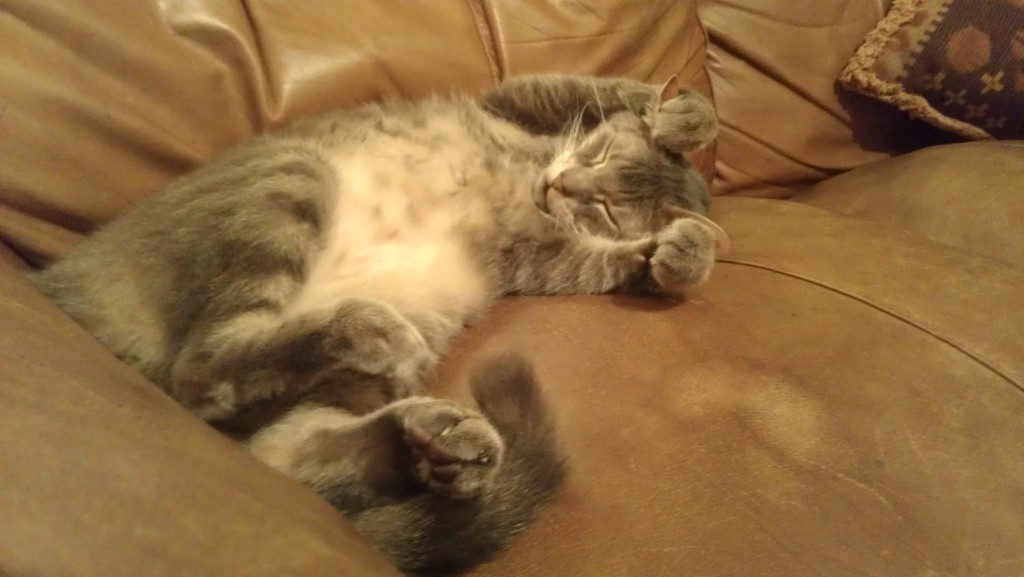
A note to all those who think they want to buy a Singer based on name recognition and a long history of value: sure, go ahead and buy those old all-metal machines. They are well-made buy people who care, and I have heard that some of the best of them are used by high-end bridal shops for topstitching, as they make beautiful stitches. They are eternally fixable, and the ones with metal gears are pretty much immortal; changing out old wiring can keep them going indefinitely without even having to replace any parts.
Singer has since gone under and now sells the name out yearly. Getting a new Singer is pretty much like playing Go Fish.
The one machine I will hands down, flat out, demand that no one buy is a White serger. I have no idea about their sewing machines, but their sergers are so bad, I suspect anything by that company of being guilty by association. If you wind up with a White serger, you should probably use it as a doorstop. Or as extremely expensive electric scissors. (Actually, that sounds facetious, but I mean it; using an unthreaded, needle-less serger as an electric scissors is an effective way to get a straight cut edge. The last time I accidentally looked at a White serger, it seemed to have an impressively effective blade. There’s that, at least.) They will not keep good tension and the stitches will come out looking like it was threaded by a meth addict or like you let children play with your knobs the entire time you were sewing. Without exception everyone I have met who has a White who has asked me why they have problems with it has been unable to accept my statements that it is a bad serger, and has decided that the real reason for the terrible quality of the finished products must be their own incompetence.

Anyway, Janome quality good, BabyLock better. Janome prices great, BabyLock a little higher. I don’t know much about other brands, as these are the ones I’ve used. My mom had a Husqvarna Viking thing that was around the house when I was a kid. I liked all the features the cams had, and I still remember the doll clothes embroidered with rows of hearts or ducks. A few years of no use caused a cam to get stuck in it (luckily, the basic utility stitches, so it was still a usable machine, but not near so fancy) and even the professional she took it to couldn’t get it out.
Whelp, that’s it. I rambled off into the night. Just trying to cover some of the stuff I tell people I know when they ask for buying advice. I’m not a broad expert, but I’ve been using machines for years, and I’ve had multiple jobs selling and/or fixing them, so there you go.


